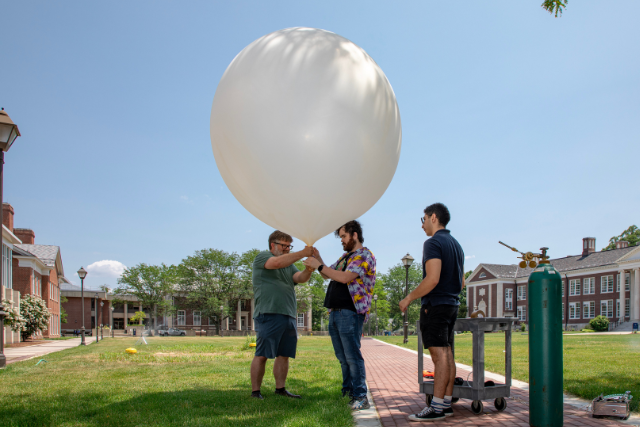
As temperatures have risen and the summer has steamed along, Physics Professor Nate Magee and a group of his student researchers have used a weather balloon to collect important data to help residents of Trenton plan for and deal with the impact of the intense heat.
As part of Magee’s Mentored Undergraduate Summer Experience project entitled “Collaborative Trenton-Mercer Heat Island and Air Quality Project,” students have been studying the urban heat island in Trenton to collect information about temperature and air quality and how the health of local residents has been impacted by the scorching summer.
“One of the things we’ve recognized is that the temperature in urban environments is significantly warmer, especially on hot summer days,” Magee said. “It can easily be 10 degrees hotter than the surrounding areas, and the air quality is usually worse as well.”
Exposure to extreme heat and poor air quality can lead to heart attacks, respiratory distress, spikes in hospital admissions and mortality rates, among other issues.
Using a high-resolution, thermal, infrared camera attached to a weather balloon, Magee and his team send up temperature measuring and positioning instruments in an insulated package tethered to the bottom of the balloon. The equipment then provides a “map” of the temperature to establish details about the scale of the neighborhood and how the heat is affecting the area.
As part of the project, Magee and his team are also installing air sensors in the ground at some Trenton-area schools to help provide accurate, real-time information about the temperature and air quality in the city, which can be difficult to capture when the main National Weather Service data for Trenton is gathered from the airport in the middle of a grass field.
“The heat island effect is a local phenomenon,” Magee said. “Neighborhoods that have a lot of trees and grass and parks can be several degrees cooler than those with more concrete, asphalt, and roofs on buildings. We are hopeful that urban planners will consider and emphasize these factors where there is an opportunity, plant more trees.”
The data collected by the balloon will be used as part of a larger project that includes a public dashboard to provide residents with information, data, and guidance as to how to stay safe and healthy during the increasing summer heat.
The fact that the results of the study could help members of the local community is especially rewarding for Magee and the participating students.
“It was especially satisfying for me because I was able to see my work out in the real world and I had the opportunity to learn about the community surrounding TCNJ,” said physics major Sam Ehret ’25,” I don’t think I would have had that chance if it wasn’t for this project.”
“My hope is that this project will inform, educate and raise awareness of the dangers of extreme heat,” Magee said. “We know there is a problem and people, who sometimes aren’t even aware of the risks, are being affected. We hope to empower people to protect themselves and advocate for community development that creates greener neighborhoods.”
The heat island project is a part of a larger interdisciplinary collaboration addressing environment-focused justice, health, and education issues in Trenton. Faculty and students from the TCNJ School of Education, journalism program, and public health program, have collaborated on these interconnected issues for the last two years. Community partners include ISLES, the New Jersey Department of Environmental Protection, The Trenton Health Team, and the Trenton Public School District.
Funding for this project was provided through MUSE, the TCNJ Environmental Sustainability Program Council, and the TCNJ Physics Department.
— Luke Sacks
